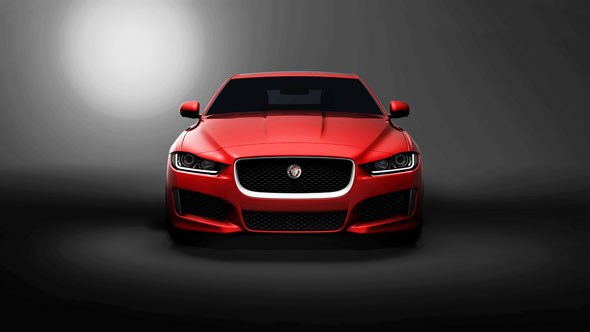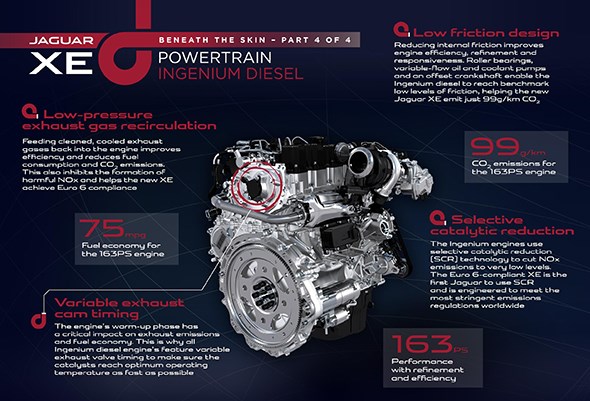
Jaguar has issued more details about the new Ingenium diesel engines powering the new Jag XE. It’s the fourth and final teaser in the build-up to the XE’s full launch at next week’s 2014 Paris motor show.
The four-cylinder Ingenium motor will be Jaguar’s most efficient production engine ever, the company vows. The Euro 6 compliant diesel is available in two states of tune:
Jaguar XE 2.0 diesel 161bhp, 280lb ft, 75mpg, 99g/km
Jaguar XE 2.0 diesel 178bhp, 317lb ft
Other petrol engines will join the range:
2.0 petrol turbo Figures to be announced
3.0 V6 supercharged Figures to be announced
Today Jag is focusing on the 2.0-litre diesel, which boasts CO2 emissions of just 99g/km – low enough to qualify for serious tax breaks in its native United Kingdom market.
The Ingenium engine has a raft of technology to enable such parsimony: Jaguar cites selective catalytic reduction and cooled low-pressure exhaust gas recirculation to cut NOx emissions and variable exhaust valve timing.
Twin balancer shafts are used to make sure the engines are quiet and niceties such as an acoustic sump cover and decoupled injectors contribute to the refinement promised, claims Jaguar.
The new aluminium engines will be built at Jaguar Land Rover’s new plant in Wolverhampton, built at a cost of £500 million. The factory will build an engine at a maximum rate of one every 36 seconds.
Read on for more details on the Jaguar XE. And click here to see the full picture gallery and details of Jag’s new 3-series rival.
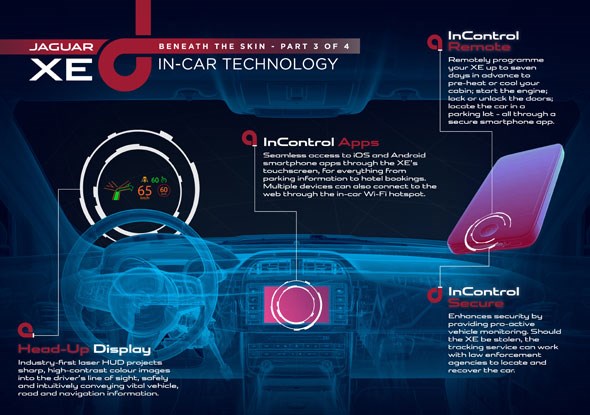
Inside the Jaguar XE’s cabin
Jaguar has issued the third of four teasers on the new XE compact exec saloon, which is due to be unveiled for real in just a few weeks’ time – and the spotlight is on the XE’s cabin. It claims a step-change in the electronics onboard, which will – hopefully – put to rest the weakest point of most modern Jags, namely their archaic infotainment systems.
The new 2015 Jaguar XE has a new tech, dubbed InControl and centred on an eight-inch touchscreen linked to voice control. It is designed to sync seamlessly with iOS and Android phones and lets owners choose the temperature of their cabin in advance, lock or open doors and even start the engine remotely from anywhere in the world, according to Jaguar.
Apps are at the heart of the XE’s InControl system – and your smartphone’s apps can be controlled through the touchscreen, so digital mapping or hotel booking can be done from behind the wheel. And the XE acts as wi-fi hotspot for multiple devices, says Jaguar, so back-seat passengers can stream data onboard while your co-driver downloads work emails.
‘In-car technologies in this ever-more connected and fast-paced world are an integral part of your driving experience,’ said Dr Mike Bell, Jaguar’s global connected car director. ‘With the all-new XE we’re introducing an entire suite of cutting-edge driver aids and entertainment systems. Designed and developed from scratch, they will ensure that every journey you take is simpler, more relaxing, safer, and effortlessly enjoyable.’
There’s one world first in today’s announcement: the Jaguar XE gets the world’s first laser head-up display (HUD) in a car. It’s said to be sharper, clearer and faster than existing HUDs on the market – not to mention weighing a third less.
And there are a few more hints in the X-ray shot inside the XE (above): studied closely, you’ll notice the XE gets Jag’s heated windscreens (a legacy of the Ford days), split climate control settings for each side, deeply dished instrument cowls and Jaguar Land Rover’s split-screen central display, letting passengers watch TV while the driver sees sat-nav instructions from the same monitor.
Read on for the earlier press releases issued in the build-up to the Jaguar XE’s world debut on 8 September 2014.
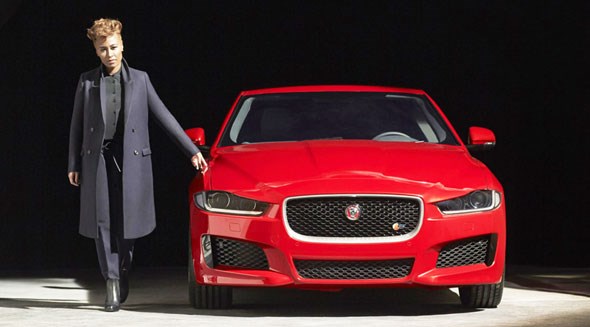
Emeli Sande poses next to the Jaguar XE
The XE dripfeed continues. Here is the latest photograph of the new Jaguar XE compact exec saloon, alongside pop star Emeli Sande. While we’re not that interested in the marketing exploits of a pop star, we are interested to see the front of the Jag XE in broad daylight for the first time.
Has the shape of the Jaguar XE’s headlamps and bumper changed since the first shadowy teaser was issued earlier in 2014? At first we thought so, and mocked up the two views of the XE side-by-side. Design chief Ian Callum quickly responded to our claims and vowed ‘it’s exactly the same car,’ explaining that subtle differences in lenses and angles were responsible for any changes we perceived.
We’ll find out for sure when Sande unveils the XE at a Thames-side spectacular on 8 September. The company has also signed up Stella McCartney and Idris Elba for the launch of the XE.
For the time being we’ve Photoshopped the two official photographs of the XE together so you can decide for yourself.
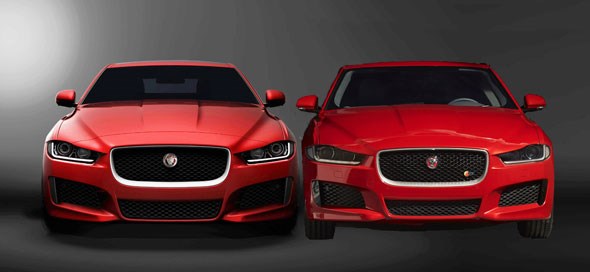
Back to matters mechanical, Jaguar also this week confirmed the new XE will better 75mpg and emit less than 100g/km of CO2 without a hybrid system in sight, making it exempt from some road taxes in the UK.
The bulk of those gains are made through the lightweight aluminium structure underpinning the XE, says Jaguar. It claims that 75% of the bodyshell is made from aluminium, including a new grade of high-strength alloy dubbed RC 5754 that uses a high level of recycled metals. Jaguar plans to ensure that three-quarters of its materials used in construction are recycled from 2020.
‘The Jaguar XE body uses over 75% aluminium content, which far exceeds any other car in its class,’ said Mark White, Jag’s chief technical specialist in body materials. ‘This gives us a body structure with unrivalled low weight: it’s light, but also immensely strong with extremely high levels of torsional stiffness.’
The company is planning a steady drip-feed of technical highlights before the covers are whipped off in their entirety on 8 September 2014 at an event in London.
Today’s announcement reveals the latest engineering secrets of the Jaguar XE and is designed to whet the appetites of those premium car buyers ready for a change from their 3-series, A4s and C-classes. Read on for a recap on the earlier Jag XE news releases.
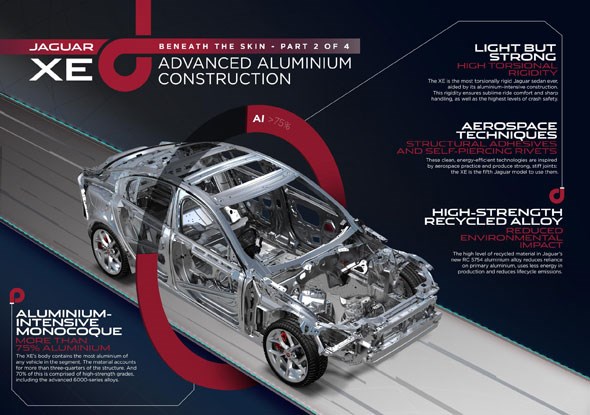
Jaguar XE: ‘a true driver’s car’
The Jag XE borrows suspension from elsewhere in the family, the company confirmed today. The front axle’s double wishbone set-up is based on that in the F-type roadster and coupe, while a multi-link rear suspension – dubbed Integral Link – features at the back.
Jaguar claims its electric power steering (the company’s first) will reset the benchmark in the class for feeling and response. This may set off alarm bells among traditionalists, who fear dumping hydraulic assistance risks the whole feeling of driving a Jaguar.
But while many manufacturers make similar claims, we have good reason to be hopeful that Jag may just crack the e-steering problem: the XE will be the only car in its class to rely on an aluminium-intensive architecture and its larger sports saloons are renowned for steering feel.
The man responsible for making Jaguars feel the way they do, chief engineer Mike Cross, said: ‘Jaguars have always been renowned for a balance of precise handling and a high-quality ride. The XE is the culmination of everything the company has learned over the years. The Integral Link rear suspension provides a combination of supple ride and crisp handling that is unmatched in this segment. We are on target to deliver a vehicle that dynamically outperforms our rivals.’
Jaguar announced last week the first details of its new Ingenium four-cylinder engines. The cleanest XE will emit less than 100g/km of CO2, thanks to the new British-built motors destined to be manufactured in Wolverhampton.

Jag XE suspension
The XE will have many of its suspension components made from forged or hollow-cast aluminium in a bid to reduce unsprung mass yet keep the lateral and longitudinal stiffness essential to keep handling precision up.
This is the secret, says Jaguar, to delivering ‘sharp response and handling while retaining a refined, luxurious ride.’
Also of note is Jaguar’s new All Surface Progress Control, a system using electronics to act as a differential on the back wheels. It’s designed to stop rear-wheel drive cars scrabbling for traction on low-grip surfaces, such as snow and ice. It’s rather like Volkswagen’s XDS system offered on the Golf GTI.
Jaguar XE world debut in London
The XE will be unveiled to the world at an event in London on 8 September 2014. Expect celebrity endorsements and much hoopla; this is an incredibly important launch for Jaguar Land Rover and it can’t afford to ‘do another X-type,’ the firm’s last attempt at a compact exec under Ford’s ownership.
Expect plenty of references to Jag’s sporting history in the saloon market, with nods to the Mark II that the company claims invented the sports saloon sector.
>> Stay tuned for more Jaguar XE news in the run-up to 8 September 2014
